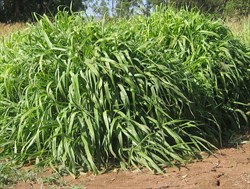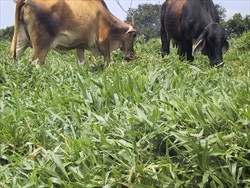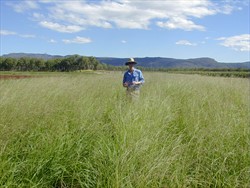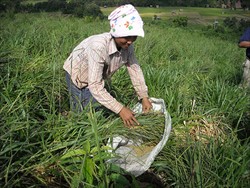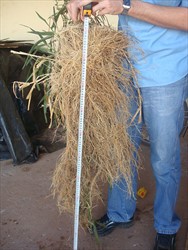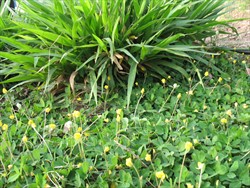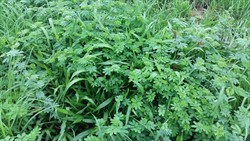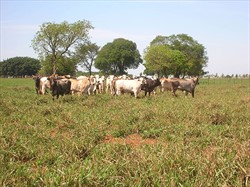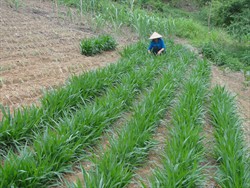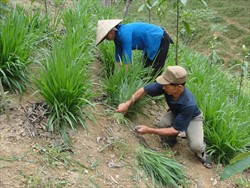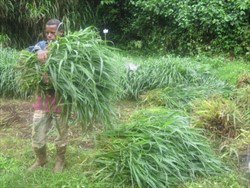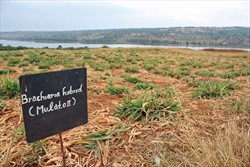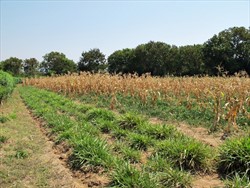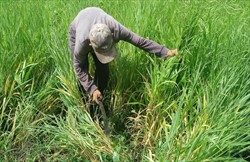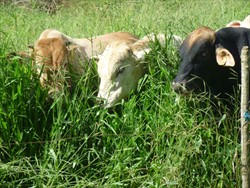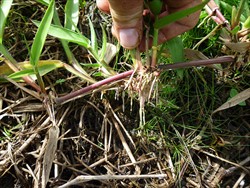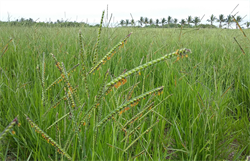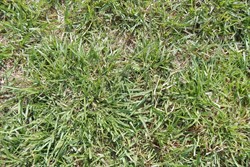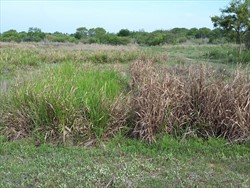Tropical Forages
Urochloa brizantha × U. ruziziensis cvv. Ipyporã, Mavuno, Mulato
Urochloa ruziziensis × U. decumbens × U. brizantha cvv. Cayman, Cobra, Mulato II
Much of the documentation on these hybrids refers to them as Brachiaria brizantha × B. ruziziensis and Brachiaria ruziziensis × B. decumbens × B. brizantha.
Using the taxonomy accepted by GRIN, Urochloa brizantha (Hochst. ex A. Rich.) R.D. Webster º Brachiaria brizantha (Hochst. ex A. Rich.) Stapf.; Urochloa decumbens (Stapf) R.D. Webster º Brachiaria decumbens Stapf.; and Urochloa ruziziensis (R. Germ. & C.M. Evrard) Crins º Brachiaria ruziziensis R. Germ. & C.M. Evrard.
Family: Poaceae (alt. Gramineae) subfamily: Panicoideae tribe: Paniceae subtribe: Melinidinae.
All are apomictic, tetraploid (2n = 4x =3 6) perennials.
Urochloa brizantha x B. ruziziensis
'Ipyporã': Prostrate to semi-erect tussock 40–60 cm high with high basal tillering; culms thin. Leaf sheaths very hairy; leaf blades lanceolate, pubescent on abaxial and adaxial surfaces. Spikelets arranged in a single row on rachis, little or no hairiness.
'Mavuno': Erect tussock, to 130 cm high; root system robust, spreading; culms rooting from the lower nodes. Leaf blades lanceolate, long, arched, moderately broad, pubescent on both sides; leaf sheaths very hairy.
'Mulato': Semi-erect tussock, 40–60 cm high; culms rooting from the lower nodes. Leaf blade lanceolate, to about 40 cm long and 25 mm wide, abaxial and adaxial surfaces densely covered with long hairs; leaf sheath densely white-pubescent; ligule membranociliate, short. Inflorescence a panicle to 12 cm long, comprising 4–8 racemes about 6 cm long; spikelets 5.5 mm long, 2 mm wide, arranged in 2 rows along the rachis; stigmas pink/maroon. 115,000 seeds per kg.
Urochloa ruziziensis x U. decumbens x U. brizantha
'Camello': Stems and leaves bright green, the only non-pubescent hybrid to date; stems thin to medium thickness with short internodes, decumbent; culms rooting from the lower nodes, requires well drained soils of medium fertility.
'Cayman': Semi-decumbent, growing to 80–110 cm without inflorescences, culm internodes strongly pubescent; initially a densely-tillered tussock; in high moisture conditions developing abundant stolons, which produce tillers and roots at the nodes. Leafblades short of medium width, moderately pubescent both sides. Panicle comprising about 4 racemes of average length about 6 cm on a rachis about 14 cm long; spikelets 5 mm long, 2 mm wide, arranged in 2 rows along the rachis; stigmas purple at anthesis. 115,000 seeds per kg.
'Cobra': Erect tussock with flowering culms to 110 cm; culm internodes moderately pubescent. Leaf blades lanceolate, long and broad, moderately pubescent both sides. Panicle comprising 3–6 racemes about 9 cm long on a rachis about 22 cm long; spikelets 5 mm long, 2 mm wide, arranged in 2 rows on each raceme; stigmas purple at anthesis. 110,000 seeds per kg.
'Mestizo Blend': Mixture of 'Mulato II' (CIAT 36087), 'Cobra' (CIAT BR02/1794) and CIAT BR02/0465. CIAT BR02/0465 is an erect tussock to 130 cm at flowering; culm internodes strongly pubescent. Leaf blades lanceolate, medium long and medium broad, pubescent both sides. Panicle comprising 4–6 racemes about 8 cm long on a rachis about 17 cm long; spikelets arranged in single row on lower half and 2 rows on upper half of raceme; stigmas purple at anthesis. 95,000 seeds per kg. 'Cobra' and 'Mulato II' are described in this section.
'Mulato II': Semi-erect/semi-decumbent tussock, growing to 80–100 cm without inflorescences and to 140 cm at flowering; culm internodes cylindrical, weakly pubescent. Leaf blades 40–60 cm long, 24 mm wide, strongly pubescent on both sides, collar hairs absent. Panicle comprising 4–6 (–8) racemes about 5–7 cm long on a rachis about 15 cm long; spikelets 5 mm long, 2 mm wide arranged in 2 rows on rachis; stigmas cream-white at anthesis. 125,000 seeds per kg.
English: In most cases, the only common names used are the cultivar names, e.g. Mulato II, sometimes preceding "grass" , e.g. Mavuno grass
Brazil: Mostly "capim" (= grass) followed by the cultivar name, e.g. capim Mavuno; belo começo (º cv. Ipyporã in Guarani)
Spanish: Mostly "pasto" (most Hispanophone countries) or "zacate" (Mexico) followed by the cultivar name
Native:
These are synthetic hybrids and do not occur naturally.
Cultivated:
They are being increasingly used in preference to traditional varieties around the world tropics and lowland subtropics.
Forage
All cultivars are mainly used for permanent pastures in both grazed and cut-and-carry systems as fresh or conserved feed. Most have further application as grazed ground cover in plantations.
Environment
Most have potential to provide good ground cover for erosion control on hillsides and for suppression of invasive species.
Other
'Mulato' and 'Mulato II' have found application in the push-pull technology for control of stem borer (Busseola fusca (Lepidooptera: Noctuidae) and Chilo partellus (Lepidoptera: Crambidae), and the parasitic weed, striga/witchweed (Striga hermonthica and S. asiatica), in maize and sorghum crops in Africa.
Note: The various hybrids have been bred and selected for performance in a range of environments, and adaptational details are provided under 'Cultivars'.
Guidelines for establishment and management of sown forages.
Establishment
The hybrid cultivars can be established from seed sown into a well-prepared seedbed at 4–6 (–10) kg/ha seed. In common with the parent species, freshly harvested seed remains dormant for several months and must be stored for at least that period or acid-scarified prior to planting. All can be planted vegetatively from rooted slips or stolon cuttings. They establish rapidly from seed and under good conditions can be lightly grazed 3–4 months after sowing.
Fertilizer
There may be marginal differences in fertilizer requirements among the hybrids, but all grow best in fertile soil and, where deficiency exists, respond well to fertility improvement, particularly nitrogen.
Compatibility (with other species)
The hybrids are mostly grown in nitrogen-fertilized pure swards, but can combine with vigorous legumes under appropriate management.
Companion species
Grasses: not normally sown with other grasses.
Legumes: Arachis pintoi, Calopogonium mucunoides, Centrosema molle, D. intortum, Grona heterocarpa ssp. ovalifolia, Leucaena leucocephala, Neustanthus phaseoloides, Stylosanthes spp.
Pests and diseases
One of the main selection criteria has been resistance to spittlebugs/cercopids/froghoppers (Hemiptera: Homoptera: Cercopidae), a group of sucking insects that is particularly damaging to Urochloa in South America. Plants can resist this damage through three mechanisms, antibiosis, antixenosis and tolerance. Antibiosis is the degree to which the plant affects the fitness of the insect feeding on it, antixenosis is the degree to which the plant is avoided when the insect is able to select other plants, and tolerance is the degree to which the plant can withstand or repair damage caused by the insect, without compromising the insect's growth and reproduction. Antibiosis and tolerance are the main factors in selection for cercopid resistance in Urochloa. The main disease in some of the cultivars is Marandu Death Syndrome (síndrome da morte do capim-marandu), where large patches of the stand die out in stands growing on even temporarily waterlogged soils or subjected to short periods of inundation.
Ability to spread
All have the potential to spread from seed, while the potential for vegetative spread varies according to the level of root development on from lower culm nodes. The level of spread from rhizomes is minimal.
Weed potential
Likely to be similar to U. brizantha, having potential to colonise disturbed areas.
See 'Cultivars'.
See 'Cultivars'.
A number of cultivars of the three closely related species, Urochloa brizantha, U. decumbens and U. ruziziensis have been released around the world tropics since 1966. While these have all made a valuable contribution in their own right, over the years each has been shown to be susceptible to a range of environmental stresses, in particular spittlebugs/cercopids (Hemiptera: Cercopidae), low soil pH and the associated high aluminium saturation on the exchange complex, and poor internal soil drainage. In 1988, CIAT, and in 1992, Embarpa Gado de Corte, commenced Urochloa breeding programs in an endeavour to combine the most valuable traits displayed by the three species. The difficulty posed was that U. brizantha and U. decumbens were apomictic tetraploids and the common line of U. ruziziensis was a sexual diploid, creating difficulties in interspecific hybridization. This was initially overcome by colchicine tetraploidisation of U. ruziziensis. Hybrids were then created using this as the seed parent with pollen from the two apomictic species. Since then, natural tetraploid U. ruziziensis populations have been identified. Breeders now had the capacity to produce better adapted varieties, at the same time maintaining, and even enhancing, the leafiness and high nutritive value of the parent species. Following cycles of hybridization and selection, apomictic individuals were selected and have gradually been progressed to cultivar status through agreements with commercial partners.
See 'Cultivars'.
No information available.
- High DM production.
- Good forage quality.
- Purpose-selected, e.g. soil adaptation, cut-and-carry.
- Tolerance of spittlebugs.
- High soil fertility requirements.
- High seed cost.
Hare, M.D., Pizarro, E.A., Phengphet, S., Songsiri, T. and Sutin, N. (2015) Evaluation of new hybrid brachiaria lines in Thailand. 1. Forage production and quality. Tropical Grasslands-Forrajes Tropicales 3:83−93. doi.org/10.17138/tgft(3)83-93
Hare, M.D., Pizarro, E.A., Phengphet, S., Songsiri, T. and Sutin, N. (2015) Evaluation of new hybrid brachiaria lines in Thailand. 2. Seed production. Tropical Grasslands-Forrajes Tropicales 3:94−103. doi.org/10.17138/tgft(3)94-103
Miles, J.W., Cardona, C. and Sotelo, G. (2006) Recurrent selection in a synthetic brachiariagrass population improves resistance to three spittlebug species. Crop Science 46:1088–1093. doi.org/10.2135/cropsci2005.06-0101
Miles, J.W., Valle, C.B. do, Rao, I.M. and Euclides, V.P.B. (2004) Brachiariagrasses. In: Moser, L.E., Burson, B.L. and Sollenberger, L.E. (eds) Warm-Season (C4) Grasses. Agronomy Monograph No. 45. ASA, CSSA, SSSA, Madison, WI, USA. p. 745–783. doi.org/10.2134/agronmonogr45.c22
Peters, M., Franco, L.H., Schmidt, A. and Hincapié, B. (2003) Especies forrajeras multiproposito: Opciones para productores de Centroamerica. Centro Internacional de Agricultura Tropical (CIAT), Cali, Colombia. hdl.handle.net/10568/54681
Triviño, N.J., Perez, J.G., Recio, M.E., Ebina, M., Yamanaka, N., Tsuruta, S., Ishitani, M. and Worthington, M. (2017) Genetic diversity and population structure of Brachiaria species and breeding populations. Crop Science 57:2633–2644. doi.org/10.2135/cropsci2017.01.0045
All are apomictic, tetraploid (2n = 4x = 36) perennials and most are protected under Plant Breeder's Rights (PBR) or marketed under Trademark names. While much of the promotional material for the cultivars focuses on their high yields and nutritonal value, it should be remembered that both are strongly related to the fertility of the soil and the cutting or grazing management. Tropical Forages takes no responsibility for any claims made by PBR licensees and repeated herein, but not supported by scientifically published data. However, it can be fairly safely assumed from historical evidence in relation to the component species that all can be managed to be productive and nutritious, and of significant benefit to livestock production in accordance with website information.
Urochloa brizantha x B. ruziziensis
'Ipyporã' (BRS RB331) Released by Embrapa Gado de Corte in partnership with UNIPASTO (2017). Initial cross made in 1992. Selected for high productivity, vigour and quality, and adaptation to Cerrado soils. High resistance to the sugarcane spittlebug (Mahanarva fimbriolata Hemiptera: Cercopidae) and pasture spittlebugs (Deois and Notozulia), the most important pasture pests in Brazil. It is adapted to well-drained medium to high fertility soils. It has good dry season performance, but is intolerant of waterlogged conditions and not recommended for areas with drainage problems or where Marandu Death Syndrome occurs. Cattle grazing 'Ipyporã' have produced better average daily LWG than those on 'Marandu'. It is well-suited for feeding animals with high nutritional demands such as weaned yearlings or cows in late gestation and lactation. Its dense, low growth and high leaf percentage provide excellent soil cover and competition with weeds.
'Mavuno' Released by Wolf Sementes, Brazil (2013); evaluated in Brazil by Instituto de Zootecnia de São Paulo. High spittlebug resistance and drought and shade tolerance. For use in soils of medium to high fertility and tolerant of low soil pH. More productive, more vigorous early season growth and regrowth, and better cold tolerance than 'Marandu' and 'Toledo'. Rapid recovery after fire. Suitable for grazing and haymaking to feed cattle, sheep and goats.
‘Mulato’ (CIAT 36061) Released by Papalotla, Mexico (2000). The first cultivar to be released from the CIAT breeding program. Selected for tolerance of high soil aluminium, plant vigour, DM production and forage quality. Agronomic performance assessed around the world tropics. DM yields of up to 25 t/ha and LWG up to 0.9 kg/head/day have been reported. While it has been suspected of saponin intoxication in Boer goats fed a ration of 'Mulato' hay, this does not seem to have been a problem elsewhere. It largely failed in the market due to generally poor seed yields.
Urochloa ruziziensis x U. decumbens x U. brizantha
'Camello' (CIAT BR04/3025). Selected for high growth rate, early season growth drought tolerance and resistance to pests and disease; the only non-pubescent hybrid to date. As with many of the hybrids, 'Camello' establishes rapidly. Suitable for the dry tropics and areas with marked periods of drought. Moderately susceptible to Rhizoctonia foliar blight caused by Rhizoctonia solani.
'Cayman' (CIAT BR02/1752) Initially released in Mexico, Guatemala, Honduras and the USA in 2011. Selection based on general agronomic merit in field trials, including tolerance of waterlogging, and spittlebug resistance from greenhouse evaluation using artificial infestation. While it has greater tolerance of waterlogging than other cultivars, it is also drought tolerant, and can be sown in areas with annual rainfall down to 800 mm. Requires medium to high soil fertility. Low shade tolerance.
'Cobra' (CIAT BR02/1794) Initially released in Mexico and Argentina in 2013. It has the advantage over other cut-and-carry forages by virtue of not only producing a greater amount of forage with high protein content, but also presenting high digestibility (69%) and palatability. Animals therefore prefer this hybrid over other forages such as forage sorghum. 'Cobra', unlike 'Mulato II' and 'Cayman', has an erect growth habit with well-defined tussocks, which is ideal for cut-and-carry. This type of growth allows it to recover quickly from both cutting and grazing.
'Mestizo Blend' (Mixture of 'Mulato II' (CIAT 36087), 'Cobra' (CIAT BR02/1794) and CIAT BR02/0465). Selected for complementarity of traits in a trio of compatible genotypes to provide resilience to biotic and abiotic stresses, thus increasing productivity.
‘Mulato II’ (CIAT 36087, Hispanosphere); 'Convert' (HD364, Brazil). Initially released in Colombia and Mexico in 2005, and subsequently in some 50 countries around the world. Product of 3 generations of crosses and screening carried out by the Tropical Forages Project of CIAT since 1989 between Urochloa ruziziensis (sexual tetraploid), U. decumbens and U. brizantha (apomictic tetraploid). Selected for tolerance of high soil aluminium, plant vigour, dry matter production and forage quality. Propagation by seed. Very leafy, good quality (CP and IVDMD). Best in well-drained soils; stands subject to over a week of waterlogged soil conditions may die. “Marandu death syndrome” (síndrome da morte das pastagens (SMP)) has contributed to the decline in its productivity and persistence in central and northern Brazil.
Elite hybrid lines have been identified that may find specific application to support existing cultivars.
